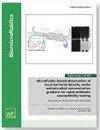Machine learning classification of cellular states based on the impedance features derived from microfluidic single-cell impedance flow cytometry
IF 2.6
4区 工程技术
Q2 BIOCHEMICAL RESEARCH METHODS
引用次数: 0
Abstract
Mitosis is a crucial biological process where a parental cell undergoes precisely controlled functional phases and divides into two daughter cells. Some drugs can inhibit cell mitosis, for instance, the anti-cancer drugs interacting with the tumor cell proliferation and leading to mitosis arrest at a specific phase or cell death eventually. Combining machine learning with microfluidic impedance flow cytometry (IFC) offers a concise way for label-free and high-throughput classification of drug-treated cells at single-cell level. IFC-based single-cell analysis generates a large amount of data related to the cell electrophysiology parameters, and machine learning helps establish correlations between these data and specific cell states. This work demonstrates the application of machine learning for cell state classification, including the binary differentiations between the G1/S and apoptosis states and between the G2/M and apoptosis states, as well as the classification of three subpopulations comprising a subgroup insensitive to the drug beyond the two drug-induced states of G2/M arrest and apoptosis. The impedance amplitudes and phases used as input features for the model training were extracted from the IFC-measured datasets for the drug-treated tumor cells. The deep neural network (DNN) model was exploited here with the structure (e.g., hidden layer number and neuron number in each layer) optimized for each given cell type and drug. For the H1650 cells, we obtained an accuracy of 78.51% for classification between the G1/S and apoptosis states and 82.55% for the G2/M and apoptosis states. For HeLa cells, we achieved a high accuracy of 96.94% for classification between the G2/M and apoptosis states, both of which were induced by taxol treatment. Even higher accuracy approaching 100% was achieved for the vinblastine-treated HeLa cells for the differentiation between the viable and non-viable states, and between the G2/M and apoptosis states. We also demonstrate the capability of the DNN model for high-accuracy classification of the three subpopulations in a complete cell sample treated by taxol or vinblastine.基于微流控单细胞阻抗流式细胞仪得出的阻抗特征对细胞状态进行机器学习分类
有丝分裂是一个重要的生物过程,母细胞经过精确控制的功能阶段,分裂成两个子细胞。有些药物会抑制细胞有丝分裂,例如,抗癌药物会与肿瘤细胞增殖相互作用,导致有丝分裂在特定阶段停止或最终导致细胞死亡。将机器学习与微流控阻抗流式细胞仪(IFC)相结合,为在单细胞水平上对药物处理过的细胞进行无标记、高通量分类提供了一种简洁的方法。基于 IFC 的单细胞分析会产生大量与细胞电生理参数相关的数据,而机器学习有助于建立这些数据与特定细胞状态之间的相关性。这项工作展示了机器学习在细胞状态分类中的应用,包括 G1/S 和细胞凋亡状态之间以及 G2/M 和细胞凋亡状态之间的二元区分,以及由三个亚群组成的对药物不敏感的亚群在 G2/M 停止和细胞凋亡两种药物诱导状态之外的分类。作为模型训练输入特征的阻抗振幅和相位是从药物治疗肿瘤细胞的 IFC 测量数据集中提取的。这里使用的深度神经网络(DNN)模型的结构(如隐层数和每层神经元数)针对每种给定的细胞类型和药物进行了优化。对于 H1650 细胞,我们在 G1/S 和细胞凋亡状态之间的分类准确率为 78.51%,在 G2/M 和细胞凋亡状态之间的分类准确率为 82.55%。对于 HeLa 细胞,我们在 G2/M 和细胞凋亡状态之间的分类准确率高达 96.94%,而这两种状态都是由紫杉醇处理诱导的。对于长春新碱处理过的 HeLa 细胞,我们在区分存活和未存活状态以及 G2/M 和凋亡状态方面取得了接近 100% 的更高准确率。我们还展示了 DNN 模型对经紫杉醇或长春碱处理的完整细胞样本中的三个亚群进行高精度分类的能力。
本文章由计算机程序翻译,如有差异,请以英文原文为准。
求助全文
约1分钟内获得全文
求助全文
来源期刊

Biomicrofluidics
生物-纳米科技
CiteScore
5.80
自引率
3.10%
发文量
68
审稿时长
1.3 months
期刊介绍:
Biomicrofluidics (BMF) is an online-only journal published by AIP Publishing to rapidly disseminate research in fundamental physicochemical mechanisms associated with microfluidic and nanofluidic phenomena. BMF also publishes research in unique microfluidic and nanofluidic techniques for diagnostic, medical, biological, pharmaceutical, environmental, and chemical applications.
BMF offers quick publication, multimedia capability, and worldwide circulation among academic, national, and industrial laboratories. With a primary focus on high-quality original research articles, BMF also organizes special sections that help explain and define specific challenges unique to the interdisciplinary field of biomicrofluidics.
Microfluidic and nanofluidic actuation (electrokinetics, acoustofluidics, optofluidics, capillary)
Liquid Biopsy (microRNA profiling, circulating tumor cell isolation, exosome isolation, circulating tumor DNA quantification)
Cell sorting, manipulation, and transfection (di/electrophoresis, magnetic beads, optical traps, electroporation)
Molecular Separation and Concentration (isotachophoresis, concentration polarization, di/electrophoresis, magnetic beads, nanoparticles)
Cell culture and analysis(single cell assays, stimuli response, stem cell transfection)
Genomic and proteomic analysis (rapid gene sequencing, DNA/protein/carbohydrate arrays)
Biosensors (immuno-assay, nucleic acid fluorescent assay, colorimetric assay, enzyme amplification, plasmonic and Raman nano-reporter, molecular beacon, FRET, aptamer, nanopore, optical fibers)
Biophysical transport and characterization (DNA, single protein, ion channel and membrane dynamics, cell motility and communication mechanisms, electrophysiology, patch clamping). Etc...
 求助内容:
求助内容: 应助结果提醒方式:
应助结果提醒方式:


